FIRES
DROUGHT
WATER SHORTAGES
RECORD TEMPERATURES
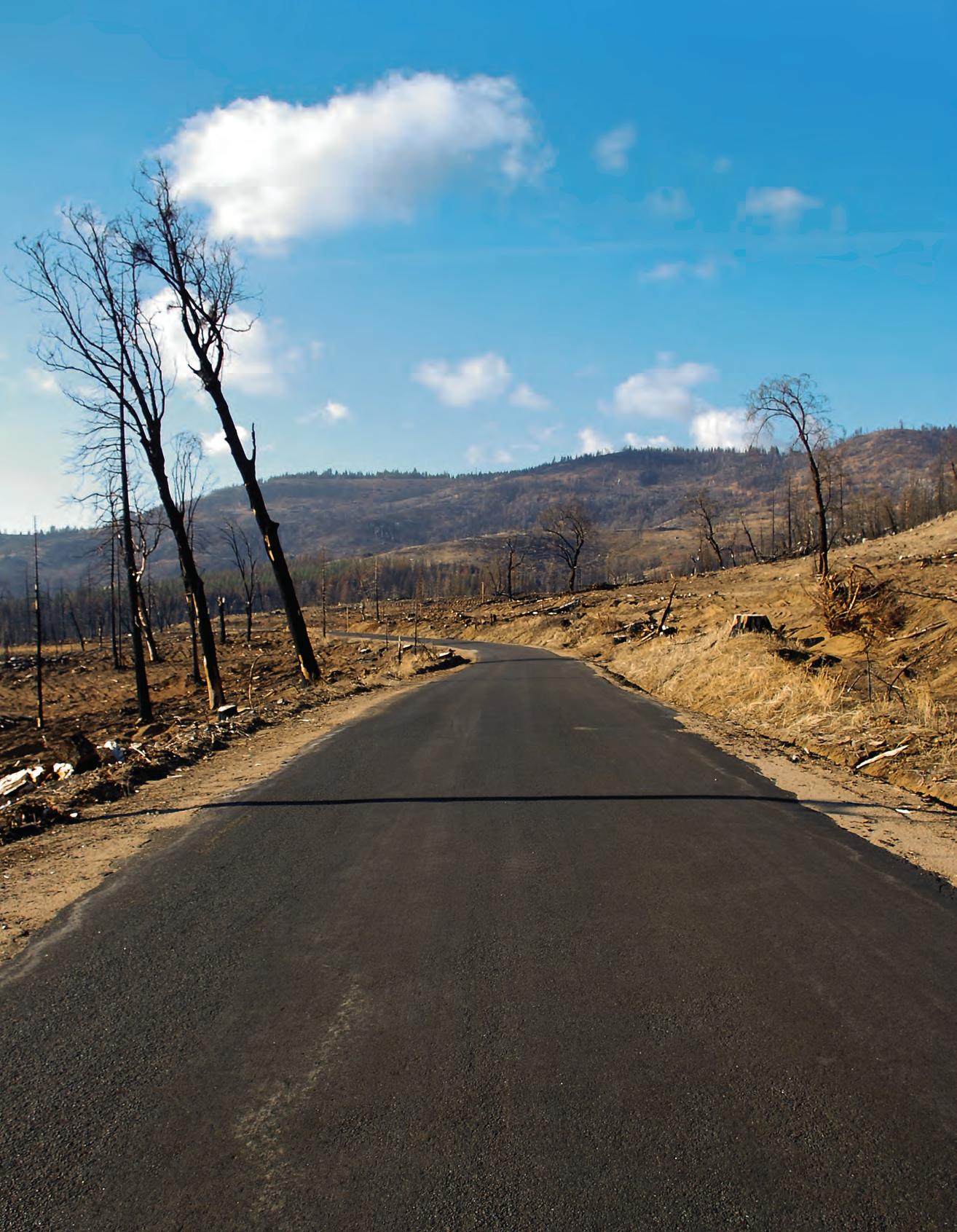
CITY COLLEGE OF SAN FR ANCISCO • SPRING 2015
The undeniable signs of climate change The undeniable signs of climate change
FRONT COVER:
Photo by Jesse Van Fleet.
The 2013 Rim Fire – the worst forest fire in Sierra Nevada history – consumed 400 square miles in Stanislaus National Forest and Yosemite National Park. The cover image was taken along Cherry Lake Road in Stanislaus National Forest, where the fire devasted the landscape.
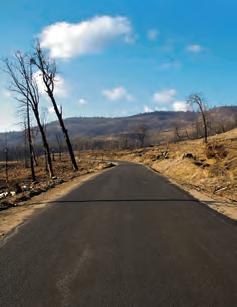
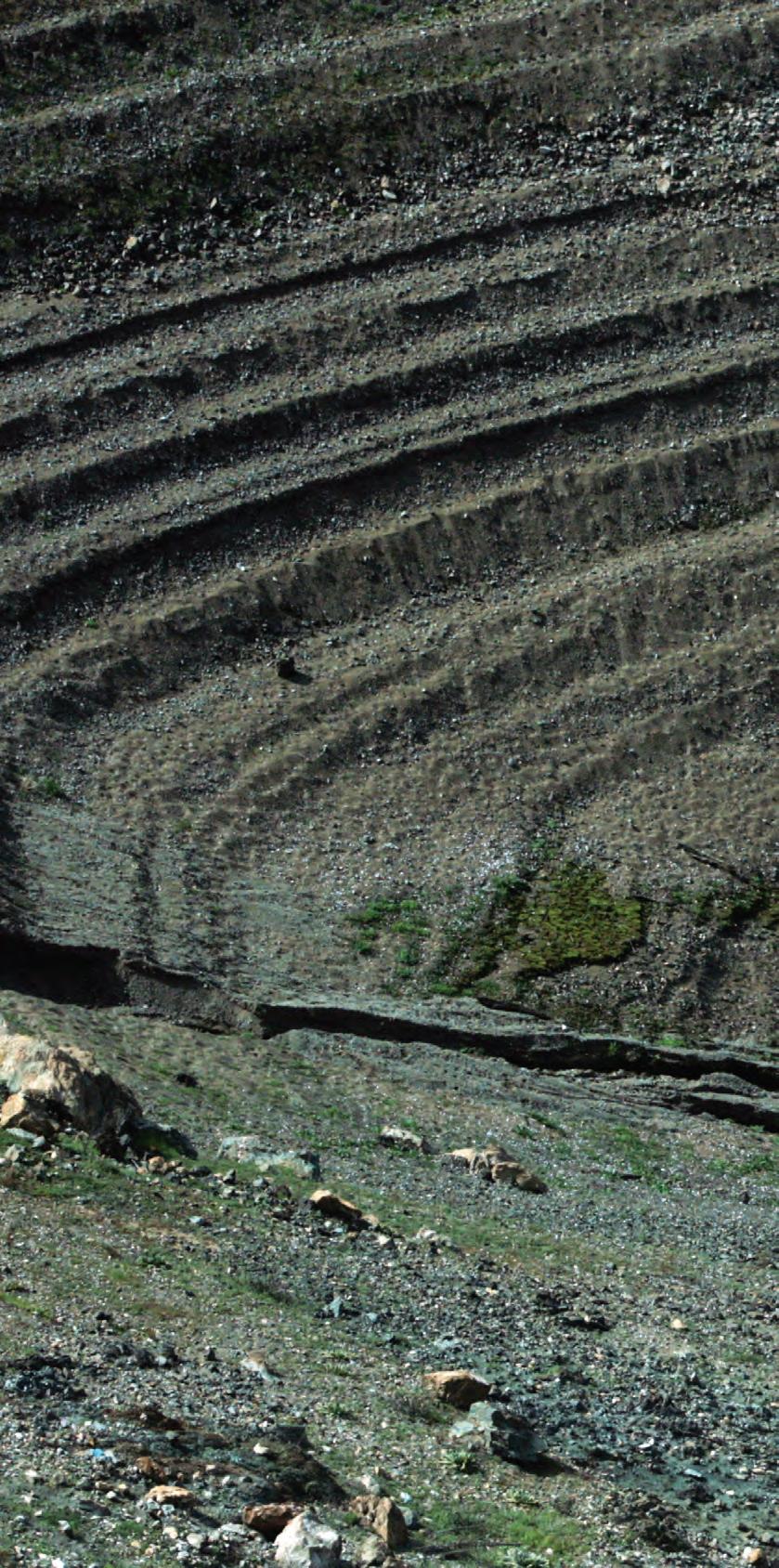
BACK COVER:
Design by David Hacket. Emerge Studio/Design Studio Practicum Visual Media Design Department.
SPECIAL THANKS:
Etc. magazine would like to thank Colin Hall, as well as John Seckman and Patricia Chytrowski’s design students for submitting their back cover promo ad designs. We would also like to thank Manuel Saballos and James Fanucchi, our Mission Campus Media Center lab technicians. And finally, Muddy’s Cafe for allowing our editing staff to meet when the Mission campus was closed on weekends and holidays.
ABOUT ETC. MAGAZINE:
Etc. magazine is an award-winning student publication. It is written, edited, photographed, illustrated, designed, produced and distributed by students enrolled in the Journalism program at City College of San Francisco.The magazine is devoted to fair and objective reporting. We cover the important issues facing the college, its students, faculty, staff, administration, and the surrounding community. Any opinions expressed in the publication represent the views of the students who authored them. Etc. does not purport to represent the views of the school’s administration. The magazine comes out twice a year—once in the spring and again in the fall.
Editorial
EDITOR
Michaela Payne michaela.k.payne@gmail.com
MANAGING EDITOR
Jesse Van Fleet jesseseducation@gmail.com
WRITERS
Sarah Calvello
Chris Moreno
Viktoriia Parubets
Michaela Payne
Lola Preza
Cara Stucker
Administration
MAGAZINE ADVISER
Tom Graham tg_journalist@comcast.net
Art & Production
DESIGN DIRECTOR & GRAPHIC DESIGN
Michel Fraser michel_f@att.net
PHOTO EDITOR & PRODUCTION MANAGER James Fanucchi james@photojour.com
PHOTOGRAPHERS
Chris Moreno cmoreno09@gmail.com
PRINTING DPI Printing www.dpi-sf.com sanjay@dpi-sf.com
CITY COLLEGE OF SAN FRANCISCO SPRING 2015
FIRES DROUGHT WATER SHORTAGES RECORD TEMPERATURES
The undeniable signs of climate change
The of change



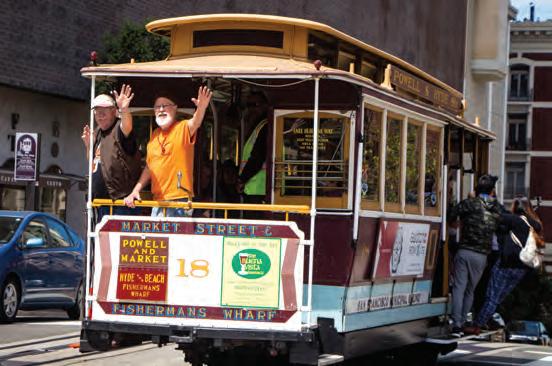
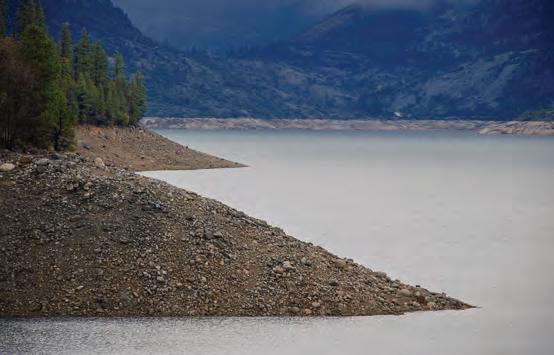

CONTENTS A GRIPPING PROFESSION 3 CLIMATE CHANGE 7 BACK IN THE UKRAINE 14 WHEELING AND DEALING 17 BREAKING BORDERS 11 1 ETC. MAGAZINE • Spring 2015 Contents |
EDITOR’S NOTE
This issue of Etc. magazine is about persistence. Threatened by closure over the past several years, City College is still open. At Etc. magazine, we have moved beyond the accreditation crisis to once again focus on the vitality and diversity that makes our school so great.
Our spring semester staff has contributed stories from all over the map – and about the world’s changing map.The issues we face stretch beyond our school community, because climate change has and will continue to affect us globally. But our community is a brilliant resource for solutions to any crisis – environmental or otherwise.
In this issue, our writers explore distance, whether navigating San Francisco, being far from home, or facing an emerging reality for this planet.
In our Cable Car story, we highlight the careers of two gripmen on our city’s most iconic transportation system.
Our cover story investigates California’s drought as an indicator of global climate change, in a time when we must choose paths between witnessing, resisting or perpetuating the growing climatic imbalances that are human-caused.
In a photo essay, a student photographer relives his trip to Rio de Janeiro during the World Cup. Like Ukraine, Brazil’s government walked fine lines between people and profit as it gained visibility on the global stage.
Next an expat student’s account of political crisis at home in Kyiv. Like Brazil, Ukraine’s government walked fine lines between people and profit as it gained visibility on the global stage.
Finally a student poet shares her story of navigating our school with her form of transportation, her electric wheelchair.
Congratulations to our award-winners from this semester’s Journalism Association of Community Colleges conference. Etc. received the JACC’s general excellence award for our fall 2014 issue.
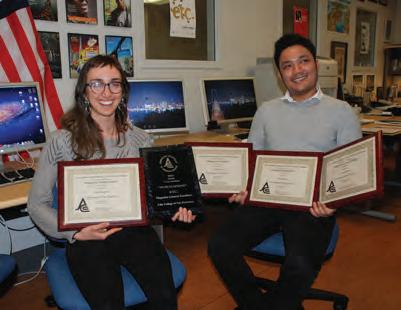
Our illustrator Zoheb Bhutia was awarded first, third, and fourth place in the magazine illustration categories for his artwork in our fall 2014 issue. Our designer, Cesar Sanchez, won second place for magazine layout from spring 2014.
We thank the JACC for their recognition and ongoing support of our publication in its thirteenth year.
Our adviser and instructor, the tireless Tom Graham, will be absent from our staff this next fall semester. His hours of work and guidance have helped run this place since its founding, by students, in 2003. His skill and humor have kept it lively. We thank him and welcome photojournalist Jessica Lifland as adviser, and look forward to seeing what this new blend of brains will create.
– Michaela Payne, editor
LETTERS TO THE EDITOR
Dear Editor: Great magazine! As a returning student, I find that reading your magazine is one of the things that makes me feel part of the CCSF community – and feel pride in our wonderful but beleaguered school!
I really enjoyed the Spring 2014 edition of Etc., especially the articles “Immersed in India” and “Amy’s Journey.” Both are very moving... I also really liked the beautiful pictures that accompanied both articles!
By the way, I saw the many awards Etc. earned last spring at the JACC. Well done!
I also appreciated the articles in Etc. about the City College accreditation crisis – in contrast to the many discouraging articles published, especially in the early days of the crisis, in San Francisco’s major mainstream paper.
– Linda Cain
Dear Editor: Concerning the article, “The Elusive B. Beno” I found it to be unfair and biast. The only “villain” in that Fall issue is still Mr. Simpson (20 Years After...). Journalists are supposed to step away from their thoughts, opinions and views, and your article was YOUR interpretation. Both sides always have to be told.
The media has quickly turned the tables from CCSF’s skeletons in the closet, to blaming the ACCJC. While Ms. Beno has her mistakes, the real issue here is the ongoing corruption of CCSF’s Administration. From former chancellor’s public funds misuse (1998 - 2008), to CCSF Administration not doing their jobs (which got the ACCJC’s attention in the first place), to not correcting the issues on time and wanting more time, to Mr. Agrella handing out raises (talk about being out of touch with lower income students/families).
Ms. Beno will be confronted and mistakes corrected (hopefully), but don’t bash her because she is bashing CCSF. CCSF should never compromise their integrity. There always have to be checks and balances for everyone. If some are “wandering off” and tempted by power, they are to be disciplined and brought back to the fold once, and then fired. Instead people looked the other way for a very long, long time.
If CCSF closes I won’t shed a tear. The school and this beautiful City think they are beyond reproach, but still can ignore and take advantage of the economically challenged. SF and CCSF need a a wake up call! Sadly the poor (as usual) will hurt the most.
I hope you do a follow up story on: The Elusive Corrupted of CCSF. Are they still amongst us, were some fired, are they hiding, why were they allowed to stay, who did what, or who did not do anything at all?
I appreciate your cheer leading for CCSF, but truth is truth.
– Tony Ortiz
2 ETC. MAGAZINE • Spring 2015 | Editor’s Note
Etc. magazine editor Michaela Payne and illustrator Zoheb Bhutia proudly display the JACC General Excellence, design/layout and illustration awards that the magazine won in April.
A GRIPPING PROFESSION
CCSF Sibs Share
Cable Car careers
By Cara Stucker
They went to the same grammar school, the same high school, the same college. And they both retired from the same career.
They grew up in San Francisco, and went to Saint Brendan’s, Saint Ignatius and City College of San Francisco.
And at a young age they each became enamored with San Francisco’s most iconic tourist attraction – the cable car.
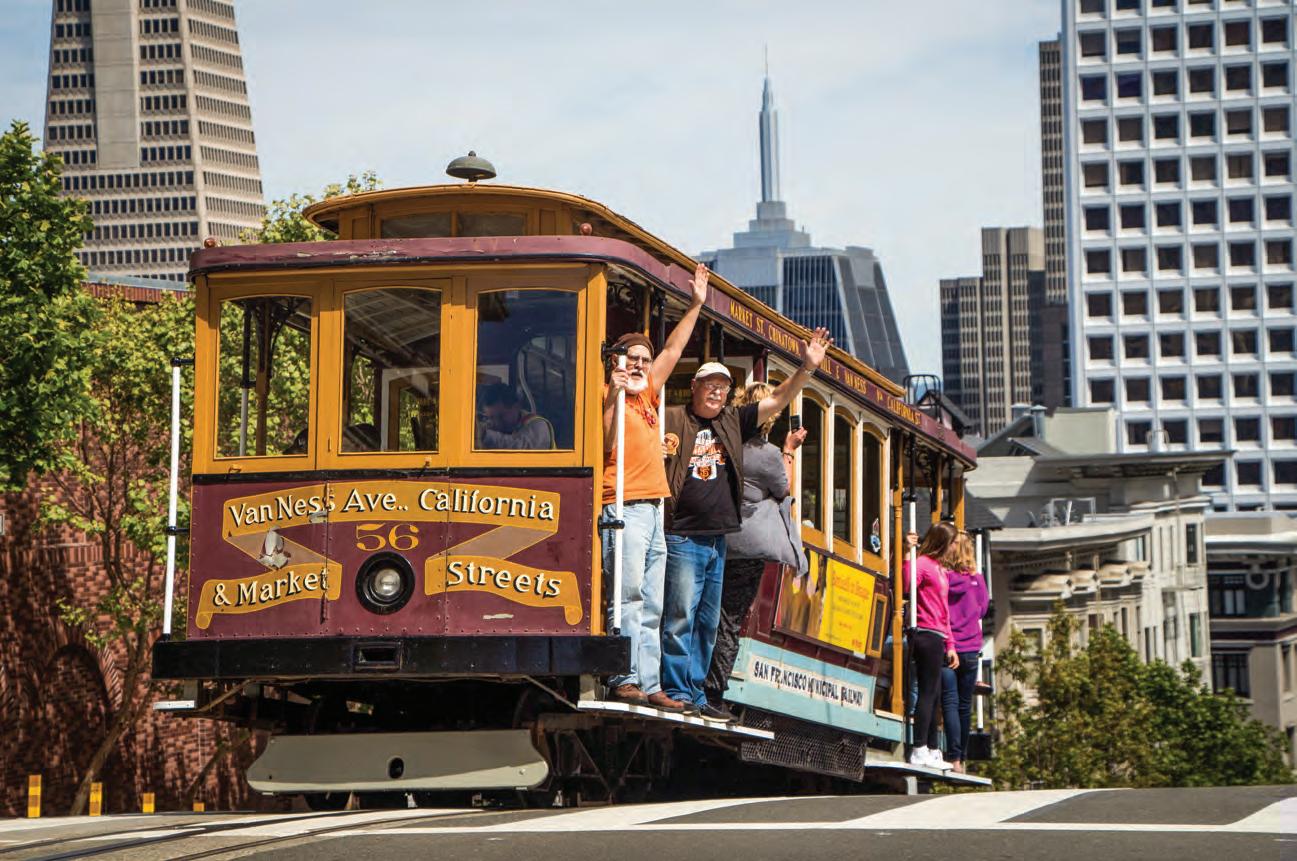
“A cable car may be the last surviving piece of public transportation that is still fun to ride,” wrote Pulitzer Prize-winning
San Francisco Chronicle columnist Herb Caen. “You see people actually smiling aboard them. You see people standing in LINE with a smile, just to ride them. A bus is a chore, a streetcar is infinitely better and a cable car is unarguably in a class by itself...”
Invented in 1873 by Andrew Hallidie to negotiate the city’s steep streets, San Francisco’s cable car was, and still is, unique.
Operating a cable car is one of the most sought-after jobs in the San Francisco Metropolitan Transportation Agency. Only a select few become “gripmen.” It’s considered an elite club.
For Ed and Ray Rezos, it is a brotherhood.
Their father, James, also worked for MUNI, as a streetcar operator. He drove
the L-Taraval to the zoo before there were houses in the Sunset District, and shared his passion with his sons.
“My father was a ‘railfan,’ and my brother and I both inherited that,” Ray said.
Although only two years apart, the brothers operate differently. Ed is an extrovert, Ray an introvert. Yet their careers paralleled – you might say they were on the same track.
Each became cable car operators, but they got there by different routes.
Marty Arbunich, who attended City College with Ray and Ed, has known the brothers for more than 40 years. He said they don’t look or act alike.
“One thing they did have in common was the cable car, and an emotional tie to street cars in general.
Ed and Ray Rezos spent nearly half their lives riding up and down the hills of San Francisco. The brothers worked as cable car gripmen for MUNI.
Photos by Chris Moreno
PROFILE 3 ETC. MAGAZINE • Spring 2015 A Gripping Profession |
“Ray’s really soft-spoken, and Eddy is pretty verbose… and animated,” Arbunich said with a laugh.
Ed had been interested in mechanical drawing, taking courses in junior high school and enhancing those skills in college. He enrolled at City College to avoid the draft during the Vietnam War. Uncle Sam drafted him anyway. He never finished college.
Ray switched his major from engineering to journalism and began writing reviews in the ’60s for Rolling Stone magazine and Beat Instrumental, a British music monthly. But he, too, didn’t finish college. It was the height of the Vietnam War and the protest movement. Classes at City College were being disrupted, as students on campuses across the country were protesting the draft.
Acid rock and protest songs captured the spirit of the time. Ray and Ed’s friend, Marty, wrote a music column for the Guardsman campus newspaper called “Labeled and Recorded.”
“We had music in common,” Marty said of the brothers, who were his former roommates.
And they all listened in fear for that dreaded phone call from the draft board, too.
Draftees were selected from a lottery. Ed was called to serve.
He arrived in Vietnam shortly after the Tet Offensive in 1968 – the worst year for U.S. casualities. Nearly 17,000 troops were
killed that year.
“As our plane approached Vietnam at night, it was dark and we could see explosions and fires on the ground,” Ed remembers. “I thought, ‘Well, I’m in it now.’ This was real serious.”
Although he didn’t lose any close friends, he knew a lot of guys who got killed.
“I never had anything traumatic happen to me even though my unit was ambushed at night. Six guys were killed, 15 were wounded – 12 seriously – and three escaped without a scratch. I was one of those three.”
Despite this, he felt he was not really fighting a war.
“We were walking around and getting shot at a lot,” Ed said. “But once engaged, we called for air strikes and artillery.”
He didn’t have an opinion of the war when he entered the Army, but said he certainly did when he returned home.
More than 58,000 U.S. military personnel were killed during the 10-year war.
“I was pretty lucky,” Ed said of his 1-year stint in Vietnam.
“I saw the way the war was fought and we weren’t fighting it like the guys in World War II and Korea. We weren’t advancing on the enemy…we were counting bodies, which seemed kind of morbid.
“I haven’t changed my mind about the war. I think it was mistake to get involved,” Ed told Etc. magazine. “I think anti-communism did far more harm to this country than communism ever did.”
After returning from Vietnam, Ed moved to Colorado.
His Army buddies, who had started a band, struggled to find gigs in California. Ed joined them on their journey to the Rocky Mountain state, where he bummed around and worked odd jobs.
He planned to move back to San Francisco and save enough to buy land in Colorado.
When he was hired by MUNI, he didn’t know he’d be staying for 32 years.
But MUNI’s benefits helped convince
him to stay in San Francisco. He now lives in the Miraloma home he grew up in.
While Ed was in Vietnam, Ray got a job at the San Francisco Water Department.
After getting some of his music reviews published in Rolling Stone, Ray had ditched the writing career.
“I didn’t have the discipline to stick with it,” said Ray, who was working full time for the City.
The Rezos brothers started as MUNI trolley bus drivers. Ed was hired in 1973, and Ray started in ’77.

They eventually became gripmen on MUNI’s cable car system. With only one out of five applicants passing the gripman training program, they were in an elite class.
During their careers, each operated all three lines – the California Street line, the Powell-Mason line and the Powell-Hyde line. Both enjoyed the notoriety of the job.
“People on vacation almost see you as a celebrity,” Ray said.
The brothers met people from all over
the world, and crossed paths with movie stars and local sports heroes. It was one of their favorite parts about the job.
Unlike driving a bus full of stressed-out commuters, operating a cable car is fun – if you consider it fun to drive an 8-ton vehicle through crowded intersections with 60 people hanging on.
“You have to know when to engage and disengage the cable and apply the brake.”
The term “gripman” refers to the operator who controls the mechanism that grips the cable, located in a slot between the tracks.
Two MUNI employees work on each cable car – the gripman, and the conductor, who assists and collects fares.
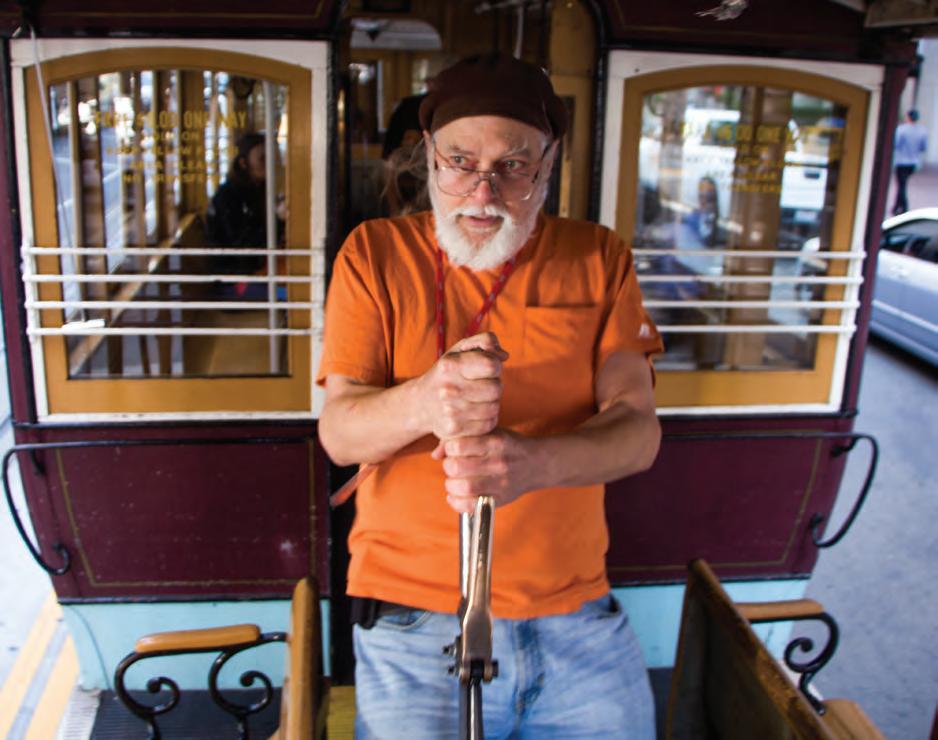
During Ray’s 14 years as a gripman, he lost control of the car only once.
Confidence, timing and focus are crucial skills for gripmen.
“It doesn’t take superhuman strength, like some people think,” Ray said. “It’s more about using leverage and getting a feel for the interaction between the grip and the cable.”
Ed said it takes a lot of training, and good instinct, to operate a cable car.
“It takes knowledge and technique, not necessarily strength,” he said.
For a practice run down Hyde Street, he and his colleagues hosed down the tracks to simulate rain.
At 3 a.m., the rails were slick. And the two main brakes were useless.
“We must have reached a speed of 50 miles per hour – totally out of control,” Ray said.
“He’s exaggerating,” his brother said with a laugh. “Fifty miles per hour is pretty damn fast for a cable car!”
The cars can’t move much faster than 9.5 miles per hour. Except downhill.
Ed Rezos, who recently retired as a cable car gripman, went to City College until he was drafted in 1968. He fought in the Vietnam War before returning to the City and starting his unusual career. The history of the iconic cable car comes alive at the Cable Car Museum, on the corner of Mason and Washington streets. The museum is free and open to the public seven days a week.

 Ed, 68, and Ray, 67, now retired as cable car gripmen, shared a life-long dream of their father’s. They got to ride the rails throughout the City every day. It was never boring, they said.
Thirty years ago, straight out of college, Ray was just beginning his career as a gripman.
Ray Rezos, now retired, recently gripped the familiar controls of one of MUNI’s cable cars.
Ed, 68, and Ray, 67, now retired as cable car gripmen, shared a life-long dream of their father’s. They got to ride the rails throughout the City every day. It was never boring, they said.
Thirty years ago, straight out of college, Ray was just beginning his career as a gripman.
Ray Rezos, now retired, recently gripped the familiar controls of one of MUNI’s cable cars.
Unlike driving a bus full of stressed commuters, operating a cable car is fun – if you consider it fun to drive an 8-ton vehicle through crowded intersections with 60 people hanging on.
4 5 ETC. MAGAZINE • Spring 2015 ETC. MAGAZINE Spring 2015 | A Gripping Profession A Gripping Profession |
The gripman’s hat is a classic piece of MUNI railway attire. Not many have it. Those who do, wear it with pride. Ed wore a beret with his operator’s uniform. Most wear gloves for this dirty job, but Ed preferred “gripping” with bare hands.

“The brakes don’t work too well in wet weather,” Ray said.
The crew had blocked off cross streets, just in case something uncontrollable were to happen – like this.
When Ray deployed the emergency slot blade, the car came to a screeching halt.
Because the steel brake had fused to the track, the cable car had to be cut free.
“It was pretty scary,” Ray said.
In this business, there’s no substitute for experience.
Toward the end of his career, Ray became MUNI’s lead cable car instructor. Ed also moved up through the ranks to become a line trainer, guiding new operators on the job.
Ray put operators through a 25-day training program, with five days devoted to
actually operating the car.
The cable cars have an intricate operating system, one that hasn’t changed in more than a century.
“Cable cars are an older technology, which is very mechanical, expensive and inefficient,” Ed explained.
Usually wearing a Giants baseball cap, Ray coached aspiring cable car operators how to “feel the grip.”
“You can talk them through situations, but they basically have to get the feel,” Ray said. “You’ve got to let people make mistakes, and see how they correct them.”
“A lot of guys would say, ‘this is too much for me… I don’t want to do this,’” Ray said.
If they make it past this first part of training, Ray said, they usually are OK.
After five days in an empty car, those
who passed the test with Ray went into line training, with senior operators like Ed.
Under Ed’s supervision, the new guys could operate a car full of passengers.
Ed and Ray have two younger sisters.
Ed didn’t marry or have kids.
“I really didn’t want to populate the Earth more than it is,” he said.
Ray and his wife, Francine, who live in Concord, just celebrated their 42nd wedding anniversary and have three grown children in their 30s, plus a two-year-old grandson.
“We got married at City Hall,” Francine said.
“On my lunch break,” Ray interjected.
Francine, who retired last June as a special ed and elementary school teacher, fondly remembers a field trip to Chinatown she set up for her third graders. What better way to add excitement to her lesson than to hop on Ray’s cable car through the historic neighborhood.
The trip was such a success that Francine repeated it with several other classes.
“Ray even let all 25 kids ring the bell,” Francine recalled with a smile. The parents and teachers also took turns.
Bell ringing is a trademark skill of the gripman. This summer, MUNI employees will compete in the 52nd annual cable car bell-ringing contest, which will be held at Powell and Market. The top six will advance to the final round at Union Square to ring in the winner.
Ed competed in a couple of MUNI’s annual cable car bell ringing contests, but didn’t win the thousand-dollar cash prize. Since he was on the clock, he did get paid. And he had fun.

Ed hung up his gripman’s hat in 2005 after 25 years. Ray retired in 2009, with 14 years as an operator, plus five years as MUNI’S lead cable car instructor.
A single ride on a cable car today will soon cost $7. One hundred and forty-two years ago, it only cost 7 cents. Back when Ray and Ed started, you could jump on a cable car from Powell and Market to Fisherman’s Wharf for 50 cents.
But Ed said jumping on and off the car was not proper etiquette.
“I didn’t like people jumping on and off the car because it was dangerous. It was an insult. They were being selfish.”
After all, it is a San Francisco landmark, albeit a moving one. The only moving one.
For Ed and Ray, their career was a great ride.
Invented in 1873, cable cars are San Francisco’s only moving landmark. One of the challenges of being a cable car gripman is dealing with old equipment, hoards of tourists and trying to keep on schedule.
6 ETC. MAGAZINE • Spring 2015 | A Gripping Profession
SIGNS OF GLOBAL WARMING
Record Droughts
Frequent Wildfires
Soaring Temperatures
The scientific evidence is overwhelming but some still refuse to believe it
By Michaela Payne and Jesse Van Fleet
The current drought is forcing Californians to come to terms with climate change.

Now in its fourth year, the state’s reservoirs and aquifers are drying up, the Sierra snowpack is critically low, forests have been laid bare by wildfires, and many regions of the state are continuing to experience record temperatures.
The signs of global warming are all there.
Photo by Jesse Van Fleet
Hetch Hetchy Reservoir, which supplies water to 2.6 million Bay Area consumers, was at 43 percent capacity in February, with little Sierra snowpack to replenish the system during spring and summer runoff.
COVER STORY
“If you’re presented with some evidence and you apply logic to that evidence, sometimes it’s very clear what the conclusions to draw are,” says Kirstie Stramler, adjunct professor in the Earth sciences department at City College and former researcher for the NASA Goddard Institute for Space Studies.
“I don’t think we have the option to wait 20 years until the next generation is in charge,” she warns.
The situation is urgent in the Golden State.
Most of the state’s major reservoirs are below 50 percent capacity, according to the California Department of Water Resources.

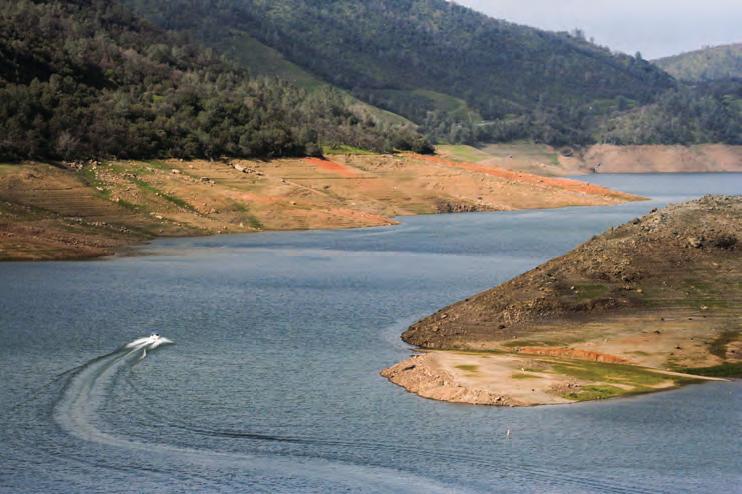
Because the state has cut back on agriculture’s water allocations, farmers and ranchers have to drill new wells in search of groundwater. As a result, the San Joaquin Valley water table is dropping at the rate of a half-inch each month.
National Geographic noted last August that Central Valley wells used to strike water at 500 feet. Now contractors have to drill down 1,000 feet or more.
In Northern California, the Sierra Nevada snowpack was at 6 percent of average for March – its lowest level since records began in 1950, according to the state’s Department of Water Resources.
“It is clear that the paltry rain and snowfall have done almost nothing to alleviate epic drought conditions,” Jay Famiglietti wrote in an opinion piece in the L.A. Times in March.
Famiglietti, a senior water scientist at the NASA Jet Propulsion Laboratory and a professor of Earth system sciences at UC Irvine noted that January was the driest month in California since record-keeping began in 1895.
“Groundwater and snowpack levels are at all-time lows. We’re not just up a creek without a paddle in California, we’re losing the creek too,” he wrote.
Earth science professor Kirstie Stramler uses the same metaphor, for climate change.
“You can’t get climate scientists to agree on anything – and they all agree that we are up shit creek without a paddle.”
Governor Jerry Brown declared a “drought emergency” last year, and imposed the state’s first-ever water use restrictions this April, calling for all water supply agencies to enforce 25 percent reductions.
“People should realize we are in a new era,” Brown said in March. “The idea of your nice little green lawn getting watered every day – those days are past.”
The governor’s warning has received mixed reviews. Climate change deniers feel Brown’s concerns are exaggerated. Environmentalists, and many climate scientists, feel the situation is worse than the governor has indicated.
“Right now the state has only about one year of water supply left in its reservoirs, and our strategic backup supply, groundwater, is rapidly disappearing,” Famiglietti’s research indicated. “California has no contingency plan for a persistent drought like this one – let alone a 20-plus-year mega-drought. Except, apparently, staying in emergency mode and praying for rain.” Although natural variability may have contributed to the recent drought in the Southwest, the National Academy of Sciences noted in 2010, “Hydrological changes in the region over the last 50 years cannot be fully explained by natural variability and instead show the signature of anthropogenic climate change.”
The Oxford Dictionaries define climate change as human-caused, attributing it “largely to the increased levels of atmospheric carbon dioxide by the use of fossil fuels.”
NASA also cites research that supports human-caused global warming.
“Multiple studies published in peer-reviewed scientific journals show that 97 percent or more of actively publishing climate scientists agree: Climate-warming trends over the past century are very likely due to human activities.”
Even the Department of Defense is concerned.
“Among the future trends that will impact our national security is climate change,” said U.S. Secretary of Defense Chuck Hagel.
“Rising global temperatures, changing precipitation patterns, climbing sea levels and more extreme weather events will intensify the challenges of global instability, hunger, poverty, and conflict,” Hagel said.
“They will likely lead to food and water shortages, pandemic disease, disputes over refugees and resources, and destruction by natural disasters,” he added.
City College’s Earth sciences instructor Kirstie Stramler says the causes are obvious – like the greenhouse effect.
“With the case of climate change,” said Stramler, “anybody who’s looked at the data and has a basic grasp of physics, is like, ‘Oh damn, we just loaded this system that we
don’t know the stability of with all this stuff that it’s extremely sensitive to,’” Stramler said.
NASA points out that human activity has increased carbon dioxide (CO2) emissions into the atmosphere by nearly 40 percent since the Industrial Revolution, causing the planet to heat up.
Increases in heat, according to Joe Cannon, an ecology and biology instructor here, are melting permafrost and ancient ice sheets, altering the Earth’s systems.
“...There’ll be no stopping. A lot of [people] have this view that it’s like a switch: turn it on, and when things get bad we can turn it off.”
People have seen the calving of polar ice on Vice, Discovery and National Geographic. They’ve seen empty reservoirs and feel unseasonably warm weather. They are aware that wildfire dangers have been more severe in recent years. But they don’t connect the dots.
Californians have experienced drought before, but NASA suggests that even this current drought pales in comparison to the ones that will follow. NASA climate models show that a “megadrought” is likely to occur here in the second half of the 21st century, with a severity that has not been seen since the Middle Ages.
Water is the critical resource for the state’s agriculture industry, which produces an estimated one-third to one-half of the nation’s fruits and vegetables.
The state’s Department of Agriculture, which has been monitoring and mapping the drought, reported “exceptional drought” conditions in more than 50 percent of California in May. In terms of drought intensity, that’s the worst. The rest of the state is rated mostly “extreme” or “severe.”
“‘Exceptional’ and then what – ‘ultra’?” Stramler said. “A little skull and crossbone pattern?”
Despite California’s mandatory conservation efforts, the state’s water is being consumed faster than it is being replenished.
Although other reservoirs throughout California are in worse shape, those that supply the Bay Area’s 2.6 million people are hovering around 50 percent capacity.
San Franciscans are already among the most eff icient water consumers in the state. An average resident uses 46 gallons a day, compared to the national average of 250, according to the Water Resources Control Board survey released in November.
“The severity of the drought has been compounded by poor planning, poor management, and population growth putting pressure on already overcommitted resources,” water and climate scientist Peter Gleick told National Geographic, “and we did not act in the first two years as though anything was abnormal.
“Clearly we are in the fourth year of a drought, but this is not just the fourth year of drought. It is the 11th year of the past 15 years that have been abnormally dry,” Gleick said in March.
Low precipitation also contributes to wildfire frequency.
“With prolonged drought, what you’re doing is priming the system to make it more flammable,” according to a Climate Desk report in 2013.
“We end up with a longer, drier, warmer fire season, which is conducive to creating the conditions that allow these large wildfires to burn.”
“The drought hasn’t created the problem – it only magnifies it,” Daniel Berlant from the California’s Department of Forestry and Fire Protection (CAL FIRE) told NBC News in April.
CAL FIRE responded to over 1,400 wildfires across the state’s wildlands in the first 5 months of this year, burning more than 6,000 acres.
Wildfires account for 5 to 7 percent of California’s carbon emissions, according to a study published this April by UC Berkeley
and the National Parks Service.
With CO2 emissions increasing, future temperatures will continue to set records.
“The current warming trend is of particular significance because most of it is very likely human-induced and proceeding at a rate that is unprecedented in the past 1,300 years,” according to NASA.
City College instructor Joe Cannon said the effects of this heat will be climate destabilization.
“It’s not just that it’s going to change. If you look at the dry years and wet years in the cycle – you’re going to get more of both. It’s going to get wetter and drier, which confuses people,” Cannon said.
Scientists fear that once CO2 and other greenhouse gases released into the atmosphere reach a certain concentration, a domino effect will begin.
The National Oceanic and Atmospheric Association (NOAA) reported that global levels of carbon dioxide, the greenhouse gas that scientists say is most responsible for global warming, surpassed 400 parts per million (ppm) in March 2015.
“Reaching 400 parts per million as a global average is a significant milestone,” said Pieter Tans, a lead scientist at NOAA. That’s up from 280 ppm since pre-industrial times – and half of the increase has occurred since 1980.
NOAA studies show that CO2 emissions, from fossil fuels, are causing more than 60 percent of the greenhouse warming.
Photo by Michaela Payne
Photo by Jesse Van Fleet
Don Pedro Reservoir’s “bathtub ring” reveals the severe impact that the drought has caused in the Sierra foothills.
Hetch Hetchy Reservoir’s water level behind O’Shaughnessy Dam (right) is far below its spillway gates (center).
‘The state has about one year of water supply left in its reservoirs, and our strategic backup supply, groundwater, is rapidly disappearing.’
8 9 ETC. MAGAZINE • Spring 2015 ETC. MAGAZINE Spring 2015 | Climate Change Climate Change |
– NASA hydrologist Jay Famiglietti
The resulting melt of land-based ice, such as glaciers, ice shelves and the Antarctic ice cap, contribute to the rising sea levels, according to NOAA.
“Global sea level rose about 17 centimeters (6.7 inches) in the last century. The rate in the last decade, however, is nearly double that of the last century,” a NASA study said.
“Sea level is projected to rise another 1 to 4 feet by 2100,” according to last year’s national climate assessment by the U.S. Global Climate Change Research Program, a team of hundreds of experts guided by a sixty-member Federal Advisory Committee.

Forty percent of the world’s population live within a hundred miles of an ocean coastline. Coastal communities will be displaced due to sea level rise, on a global scale larger than the 400,000 people displaced by Hurricane Katrina.
But coastal population growth is accelerating, according to United Nations statistics. Eighty-seven million live on the coasts in the U.S., up from 47 million in 1960, reported Climate Central. Six of the world’s 10 largest cities are on coastlines.
The American Association for the Advancement of Science (AAAS) estimates that there will be 50 million “climate refugees” by 2020. Contributing factors will include “agricultural disruption, deforestation, coastal flooding, shoreline erosion, industrial accidents and pollution.”
The refugee situation is already critical, according to Earth Island Journal. “As climate change continues unabated, there is a growing population of displaced men, women and children whose homes have been rendered unlivable.”
But here in the United States, Congress has been unable to agree on the root causes of global warming.
The Senate voted 98 to 1 in January that “climate change is real” but rejected 50 to 49 that “human activity significantly contributes to climate change.”
Anthropogenic climate change denial permeates Congress but a majority of citizens do not share their views.
In contrast, nearly 70 percent of the nation believes that climate change is both happening and anthropogenic, according to the Yale School of Forestry and Environmental Studies.
Ninety-seven percent of 12,000 peer-reviewed climate studies state that global warming is human-caused, according to a survey by Skeptical Science, but 40 percent
of Americans still believe that scientists widely disagree over whether global warming is occurring.
“When I encounter climate deniers... I ask them a simple question: what’s at stake if you’re wrong?” City College ecology instructor Cannon said. “Most of them are unwilling to finish that conversation because they know they have to say ‘Oh, I’m risking the future of humanity...on some idea I believe.’”
The White House has urged climate change action for the last five years, President Barack Obama told NBC’s Today Show weather anchor Al Roker last May.
“This is not some distant problem of the future. This is a problem that is affecting Americans right now. Whether it means increased flooding, greater vulnerability to drought, more severe wildfires — all these things are having an impact on Americans as we speak,” Obama said.
Climate change will affect more than just humans, City College biology and ecology instructor Crima Pogge pointed out.
“Our quality of life – the way we define it today – will not be the same,” Pogge said. “There is intrinsic value that other life forms have that we are jeopardizing, but that’s not the argument by which you win a lot of support.”
Part of the problem, Pogge said, is that environmental costs are not reflected in the price people pay for convenient products
that deplete our natural resources.
“Our climate… is like this commons that we don’t pay for,” said Pogge.
Environmental activist and author Paul Hawken, who writes about grassroots environmental social justice and studied at San Francisco State and UC Berkeley, equates this to a crime.
“At present, we are stealing the future, selling it in the present, and calling it GDP. We can just as easily have an economy that is based on healing the future instead of stealing it,” Hawken said in a 2009 commencement speech to University of Portland graduates.
“Whenever we exploit the Earth, we exploit people and cause untold suffering.”
City College professor Pogge said we may be doomed – but the Earth will survive.
“I take comfort in the fact that the world will go on. There were other mass extinctions. In the meantime I also hope that we do something about it in a meaningful way.”
Not everyone agrees. The late comedian George Carlin joked that trying to save the world is a delusion.
“The planet has been through a lot worse than us... hundreds of thousands of years of bombardment by comets and asteroids and meteors, worldwide floods, tidal waves… The planet isn’t going anywhere. WE are!
“We’re going away. Pack your shit, folks...
“The planet will be here for a long, long, LONG time after we’re gone... It will cleanse itself, ’cause that’s what it does. It’s a self-correcting system,” Carlin said.
If the situation were not so serious, it would be funnier. People are suffering from the impacts of climate change right now.
Yet the chairman of the U.S. Senate’s Environment Committee, Senator James Inhofe (R-Okla.), denies that climate change is human-caused.
Rep. Lamar Smith (R-Texas) says that climate change research is not in the “national interest.” But as chairman of the House Committee on Science, Space, and Technology, he influences programs at NASA, the Department of Energy, the Environmental Protection Agency and the National Science Foundation.
Hawken is hopeful, though. “If you look at the science about what is happening on Earth and aren’t pessimistic, you don’t understand the data. But if you meet the people who are working to restore this Earth and the lives of the poor, and you aren’t optimistic, you haven’t got a pulse.”
Photo by Jesse Van Fleet
10 ETC. MAGAZINE • Spring 2015 | Climate Change
The drought has exposed tree stumps once covered by Cherry Lake Reservoir.
BREAKING BORDERS
THREE PERSPECTIVES OF SOUTH AMERICA
By Chris Moreno
We wanted to break down stereotypes and bring other cultures into the spotlight. To document the little seen, often overlooked places in the world. And, most importantly, to inspire a desire for adventure through our blog.
Breaking Borders started off as a travel blog, documenting three friends’ trip to Brazil, a year in the planning. The World Cup in Rio de Janeiro had sparked protests all over the country. We wanted to document it.
I was brought along to be a writer and photographer for this trip. My friends Nick Neumann and Walker Dawson were creating an online space where we could feature our travel photos and videos.
At first, we thought that only our friends
and families would be interested. Soon, it became a forum for discussion. A place where people shared ideas about the things we were documenting.
Nick and Walker had visited some of the most exotic places on the planet –from photographing the sweaty streets of Bangkok, to smoking bidi’s beneath the Sphinx, to sipping mango lassis in Dhaka.
Listening to their stories, I eagerly anticipated wandering with them.
Although we went to Waldorf schools together, we grew up in different neighborhoods. I grew up in the Mission, Nick in the Tenderloin, and Walker in Noe Valley.
As photographers, we had each explored the City on our own. Now we would be exploring Brazil together for five months.
At the time, I loved bartending at El Techo de Lolinda, a rooftop bar in the Mission with a panoramic view of the City. But when they hired me, I knew I would be quitting that June.

We bought one-way tickets on Halloween in 2013. The three of us set a course to
Brazil for the summer World Cup.
“One of the coolest and most unique aspects of the World Cup is that it brings together people from all over the world,” Walker said. “Where else can you meet a bunch of Bosnians, Algerians, Colombians, and Nigerians in a matter of minutes?”
I was bartending almost every night, while Walker and Nick were Lyft drivers. Money was tight and saving was a struggle. My vices don’t come cheap.
We flew from San Francisco to Miami, where the warm tropic air seeped into my skin. My pace slowed to a stroll along the sands of Nikki Beach at sunset. The warm gentle surf of the Atlantic made me restless for Brazil.
We passed through a flurry of terminals on our way via the Dominican Republic.
In Rio, Portuguese street signs made navigating difficult and reminded me I was a foreigner. Eavesdropping was impossible. I could not understand a single word this side of the equator. Nothing made sense. People’s conversations sounded like music.
FIRST PERSON
Photo by Walker Dawson
11 ETC. MAGAZINE • Spring 2015 Breaking Borders |
The gold mining town of La Rinconada, Peru, population 30,000, is the highest inhabited town in the world at 16,700 feet.
Now I was an American abroad, and I felt like an awkward teenager. I struggled with the language and the currency when I went to pay for food, the bus, everything. I was indeed a gringo – albeit a very brown one.

I grew accustomed to having a camera in my hand at all times as we competed against the clock to capture the precious moments of light.
Sunrise and sunset are magic times of day. It’s all about the light, Walker said. We ran across rooftops, between buses, through jungles and over mountains chasing images. We discovered sweeping panoramas. Other times we were caught in the middle of protests, trying to outrun the police.
Rio de Janeiro is about 20 times the size of San Francisco. With 6 million people, it has about seven times the population. On a peninsula surrounded by bay, ocean and mountains, it has many similarities to our City by the Bay.
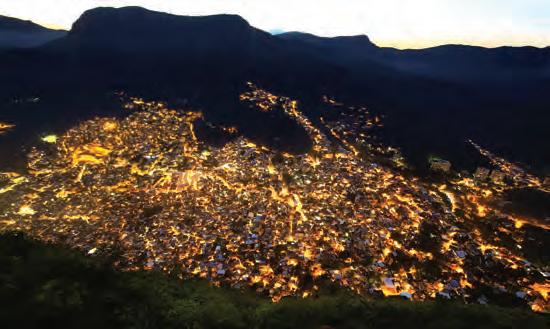

Piercing the clouds, Christ the Redeemer statue on 2,328-foot Corcovado is more imposing than the cross on San Francisco 902-foot Mt. Davidson. Forest-covered mountains caress Rio’s borders.
The natives, who call themselves cariocas, were born to be cool. I learned so much from them. Every time I struggled to find the right word, a friendly brasileiro was there to teach me. The harder I tried to perfect my pronunciation the happier they seemed.
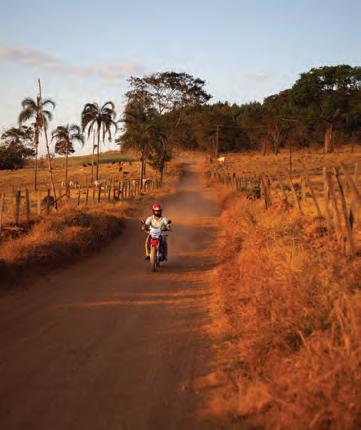
Traveling is a humbling experience. Pride disappears when you need to figure out where to sleep, eat and get water. It was a challenge to find a place to charge my camera every day… and keep my equipment dry.
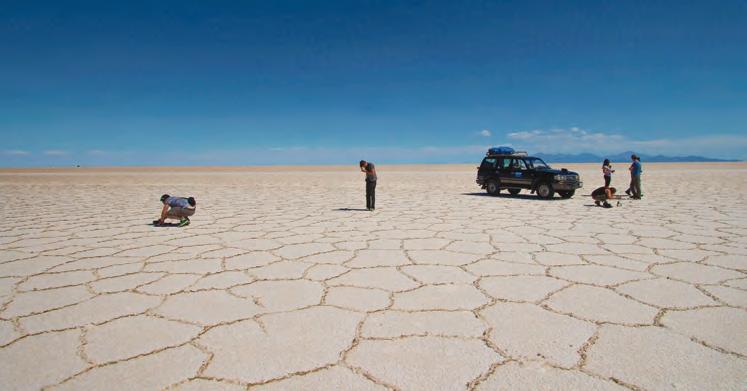
In Rio, I met local photojournalists

Patrick Granja and Guilherme Chalita, who both took turns driving us around Rio de Janeiro. They showed us how to travel under the radar and find sources in hard-toreach places. Dangerous neighborhoods like the favelas would have been off-limits to us without their escort. Other times we toured the city with them, sharing their favorite form of contraband – maconhya, Portuguese for marijuana.
Patrick described in detail what was going on during the build-up to Brazil hosting the World Cup. Favelas had been demolished and people had been forcibly relocated. The police were brutally cracking down on petty criminals, targeting low-income neighborhoods.
“We weren’t able to watch the World Cup final because we were trapped in a plaza by
thousands of military police,” Nick recalled. “They began firing tear gas, stun grenades, and pepper spray, injuring dozens of people in the process. It was definitely one of the craziest days of our lives.”
They were obviously trying to clean up the streets for the hordes of tourists that had descended upon Rio for one of the world’s most celebrated athletic events.
Perhaps a bit distracted, Brazil came in fourth place, behind Germany, Argentina and the Netherlands.
A few weeks into my trip, I was overwhelmed by all the things that were happening. The police were violent, the people
were warm. The traffic unbearable, the food delicious. And the government, well, the government was more rotten than the piles of trash that surround Rio’s favelas
I stared into the cobalt blue water of Copacabana Beach, as tourists laughed and danced to samba music, waving their souvenir Brazilian flags.
As the sun reflected off the water, I thought of the favelas I had seen, and the families I had gotten to know. This Copacabana wasn’t the real Brazil.
Through the lens of my camera I had witnessed the real Brazil. Those images were the souvenirs I would be taking home.
 Photo by Nick Neumann
Photo by Walker Dawson
Photo by Walker Dawson
Dusk on Ilha Grande, an island off the coast of Rio de Janiero. Night view of South America’s largest favela, Rocinha, Rio de Janiero.
Photo by Nick Neumann
The world’s largest salt flats (4,086 square miles) – Salar de Uyuni – are located in southwest Bolivia.
Photo by Chris Moreno
Photo by Nick Neumann
Photo by Walker Dawson
Above: The view of Rio de Janiero from the helicopter pad atop Corcovado, near the imposing statue of Christ the Redeemer.
Left: A pick-up game of soccer in one of Rio’s many favelas.
Right: A motorcyclist on an unpaved highway rides toward Ouro Verde, Goiás.
Photo by Nick Neumann
Photo by Walker Dawson
Photo by Walker Dawson
Dusk on Ilha Grande, an island off the coast of Rio de Janiero. Night view of South America’s largest favela, Rocinha, Rio de Janiero.
Photo by Nick Neumann
The world’s largest salt flats (4,086 square miles) – Salar de Uyuni – are located in southwest Bolivia.
Photo by Chris Moreno
Photo by Nick Neumann
Photo by Walker Dawson
Above: The view of Rio de Janiero from the helicopter pad atop Corcovado, near the imposing statue of Christ the Redeemer.
Left: A pick-up game of soccer in one of Rio’s many favelas.
Right: A motorcyclist on an unpaved highway rides toward Ouro Verde, Goiás.
12 13 ETC. MAGAZINE • Spring 2015 ETC. MAGAZINE Spring 2015 | Breaking Borders Breaking Borders |
Below: A subsistence farmer in Ouro Verde.
PROFILE OF A UKRAINIAN STUDENT PROTESTER
Viktoriia Parubets
Kyiv’s Maidan Square is where the protests started. At first, they were peaceful. Within a week, they turned violent. One hundred protesters were killed. To date, more than 6,000 have been killed in the conflict.
Ukrainians took to the streets when their President Viktor Yanukovych refused to sign a treaty between Ukraine and the European Union that would have established a political and economic agreement between the two.

Russia’s President Vladimir Putin was accused of bribing Yanukovych. Since the breakup of the Soviet Union, Russia has behaved like a jealous ex.
Crimea, known for its agriculture, used to be part of Ukraine and is now controlled
again by the Kremlin. It was an independent republic of Ukraine until recently. The situation is similar to “the troubles” in Northern Ireland during the ’70s.
Ukraine’s current trouble with Russia started in November 2013.

The Eastern European country is dependent for its petroleum on Russia, which has manipulated gas prices for political leverage.
When I tell people here I am from Ukraine, they usually respond: “Oh, you’re Russian?” Or “Where? Ukrainia?”
Eighty-four percent of Americans can’t find Ukraine on a map, the Washington Post reported last year. Ironically, in terms of size, Ukraine is Europe’s largest country. It has a land mass of 233,062 square miles, which makes it larger than France and slightly smaller than Texas.
Although many think Russia is Europe’s largest country, it’s not. That’s because Russia is in Eurasia.
Ukraine is bordered by the Black Sea, Romania, Poland, Belarus, Moldova, Hungary, Slovakia and Russia. Ukraine is known for its iron, seed oils and corn exports. The “Bread Basket of Europe” relies heavily on Russia for petroleum products.
The Crimean Peninsula, which is a republic of the Ukraine, is a popular tourist destination. Foreigners flock to Yalta’s beaches and wineries. The city of Yalta is where Roosevelt, Churchill and Stalin met to negotiate the surrender of Nazi Germany in 1945.
Situated on the Dnieper River, Kyiv has a population of 2.8 million people – more than three times the size of San Francisco’s.
I moved to San Francisco from Ukraine three and a half years ago with my parents. The rest of my family – my grandparents, aunts, uncles, and cousins – still reside there.
My mother, Yana Parubets, works in the Ukrainian Consulate here in the city.
ents live is not that close to the fighting, it is still Ukraine, which means this is our war and our pain,” my mother told me. My dad, Volodymyr Parubets, is worried about his dad, sister, aunts and uncles. And his friends.
“I had a lot of Russian friends, but now, since they are so influenced by propaganda, they do not hear us,” my father lamented.
“We’ve lost each other. They just don’t believe what we say because Putin draws a very different picture.”
My friends back home have participated in protests throughout the cold winter, and many of their college classes have been cancelled. Protesters threw Molotov cocktails at the Russian soldiers who were shooting at unarmed civilians.
When the fighting broke out in Maidan Square, my best friend, Mariya Venkova, a 19-year-old college student at the Kyiv-Mohyla Academy, was there.
“Standing at one of the highest points of the street where I could see the whole
Maidan,” Mariya said. “I felt so much stronger than those armed forces when I saw the thousands of people standing up for our country.
“People started shouting Slava Ukraini [Glory to Ukraine], and… Heroiyam Slava [Glory to the heroes]. It never felt as powerful and meaningful as it did right there.”
Russia was learning that the Ukrainian spirit is stronger than bullets.
My father was so stressed about being far from home that he started chain-smoking cigarettes.
“If they need me there, I will go and fight,” he said. “If they start drafting men, I will go and protect home.”
With images of our countrymen being beaten in the streets by pro-Russian forces, tension grew in our household. President Viktor Yanukovych had fled the country, and our nation was leaderless.
My cousin, Anna Labuz, who lives in Kyiv with her 2-year-old son, said life is not the same.
“We were just playing in the park with all the other little kids and then all of a sudden I saw a huge tank. It really gave me chills.
“We were not the ones provoking a war, we were just disagreeing with Yanukovych’s political actions. It’s crazy,” she said. “We don’t even have the freedom to speak our minds... Our country is governed by a president who can get easily pushed around for money.”
My TV, computer, and smartphone screens provide my only access to friends
Ukrainians supported its government’s efforts to join the European Union. Membership would have meant equal rights for workers, access to the European Investment Bank, less government corruption, and the ability to travel in Europe without visas.
Then-president Viktor Yanukovych, who was in talks with the EU, suddenly halted negotiations.
Ukrainians were upset when Yanukovych withdrew from the talks. Sensing corruption, they began protesting his indecision.
President Putin was rumored to have bribed Ukraine’s government. Preventing Ukraine from joining the EU would give Russia more influence over the former Soviet Union republic.
It’s complicated. Suffice it to say, nobody knows what’s really going on in Putin’s mind.
On the night of Nov. 21, 2013 – a week before our second Thanksgiving in America – we live-streamed Ukraine’s state-run TV news channel and watched Maidan Square fill with protesters.
We were consumed with worry for our family back home. We called our relatives and friends to check on them. They were in shock, and thought it would lead to war.
My mother was scared because her brother, dad and husband could be conscripted into Ukraine’s army.
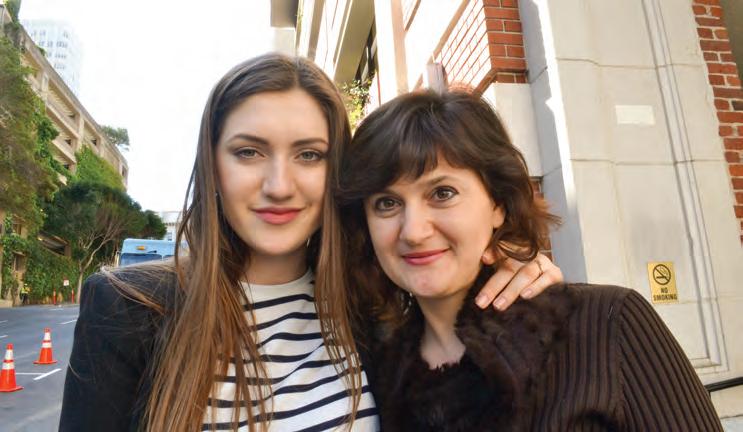
My grandmother’s health has deteriorated because of her anxiety over the situation. She is afraid every time someone knocks on the door that the men in her family would be forced to fight.
My mother grew up in the northern part of Ukraine, far from the occupied Crimean Peninsula.
“Even though the region where my par-
Photo by Chris Moreno
When the author moved here on a visa from Ukraine three years ago, she had no reason to be concerned about her family’s safety back home.
When Revolution Strikes Home
By
FIRST PERSON
The author with her mother, Yana Parubets, who works at the Ukrainian consulate in the Financial District.
Photo by Kostya Kisly
14 15 ETC. MAGAZINE • Spring 2015 ETC. MAGAZINE Spring 2015 | Back in the Ukraine Back in the Ukraine |
The author and her mother took part in a Ukrainian protest rally at Justin Herman Plaza last November, after Russia annexed Crimea.
and relatives back home.
I feel guilty that I am not there protesting in Maidan Square with everyone else.
There were many Ukrainians living in the states who feel the same way. A group of expatriates in San Francisco called Nova Ukraine (New Ukraine) organized protests, charity concerts and lectures to raise awareness about the Ukrainian crisis. I have met many people from Crimea and sympathetic Russians at rallies held in front of the Russian and Ukrainian consulates, and at Union Square, the Embarcadero, the Golden Gate Bridge and City Hall, where attendance ranged from 50 to 300 and emotions ran high.
Anastasia Mushtaev, a U.S. citizen of
Russian descent who lives here in San Francisco, thinks what is going on in Ukraine is terrible.

“How can this war be possible? Our brothers are fighting against each other,” Anastasia said.
“I have many Ukrainian friends, and what they tell me is totally different than from what I hear on Russian TV. I believe it from sources who actually have relatives living and experiencing these hardships.”

Putin’s occupation of Ukraine is unpopular with many Russians here and abroad.
Russian opposition leader Boris Nemtsov, who criticized Putin for sending Russian troops into Crimea, was assassinat-
ed in February in Moscow.
In an op-ed piece published on Sept. 1, 2014 in the Kyiv Post, he strongly criticized Putin’s stand on the Ukraine.
“Current events indicate that the most nightmarish, the most bloody scenario of fratricidal war is already developing,” he wrote. “This is not our war, this is not your war... This is Vladimir Putin’s war.”
Thousands of people gathered in central Moscow on Sept. 21, 2014 to protest against their country’s involvement in the conflict in eastern Ukraine, according to The Guardian, London’s newspaper.
The demonstration to end Russia’s “irresponsible, aggressive policy” in Ukraine drew an estimated 5,000 – according to Russia’s interior ministry – and 26,000 according to event organizers.
I’m doing what I can in this country to support my countrymen and women back home.
Although I haven’t been home in three and a half years, I’m still Ukrainian. I will be returning to the house I grew up in within a year. My family and friends will have changed because of the events they lived through. I’m hoping my country will still feel like the place I left, which might be asking a lot.
The conflict has affected our economy and lifestyle in ways that will no doubt affect all of our futures.
Our political struggle is hurting us in ways that can be measured economically, but in other ways it’s bringing us together.
Viktoriia Parubets, a marketing / advertising major at City College, pictured here with her best friend, Maria Venkova, in Kyiv’s Ghost Town District. Parubets hasn’t been home for three and a half years.
16 ETC. MAGAZINE • Spring 2015 | Back in the Ukraine
Northern California Ukrainians met at the Golden Gate Bridge recently to demonstrate against Russia’s occupation of their homeland. The recent crisis in Ukraine was sparked when Russia invaded Crimea under the guise of protecting ethnic Russians.
wheeling and dealing
Finding Balance, Fighting Fatigue
By Sarah Calvello
Hans Christian Andersen’s “The Little Mermaid” was my favorite book as a kid. It’s still my favorite fairy tale. I could relate to Ariel’s feelings of being trapped and alienated. Of wanting to be part of a world she didn’t belong in. The curse of feeling sharp pain every time she walked. I read the book over and over again until the edges were worn. The artwork captured my childhood imagination. All of the beautiful mermaids and the colorful sea flowers, especially the purple ones.
When we were growing up together, my childhood friend, Burhaun, called me
“The Little Mermaid.” He didn’t know why it made me angry or why I yelled at him. I thought he meant it as an insult because in the book Ariel couldn’t walk on land without stumbling. I realize now that he meant it as compliment. He thought I was pretty, not handicapped.
Although the book is darker than the Disney version, I prefer it because Ariel’s metamorphosis is more real to me. It helped me realize there’s beauty in pain.
“I know what you want,” the sea witch told Ariel. “It is very stupid of you, but you shall have your way, and it will bring you sorrow...
“Your tail will then disappear, and shrink up into what mankind call legs, and you will feel great pain, as if a sword were passing through you.”
When Andersen’s little mermaid was transformed into a human, she became plagued by chronic pain. At the time, it felt like he had written this for me because I was going through my own slow transformation.
At the age of six, my parents started noticing my unusual behavior. I was unsteady on my feet. I tripped and fell a lot, like Ariel.
They brought me to the hospital and I went through a bunch of tests to determine why I was having difficulty walking.
I was diagnosed with something I couldn’t even pronounce – Friedreich’s ataxia (FA) – a form of muscular dystrophy. In simple terms, it affects my balance and coordination and causes muscle fatigue and weakness.
A year later my parents gave me my first wheelchair. It was hard for me to accept my
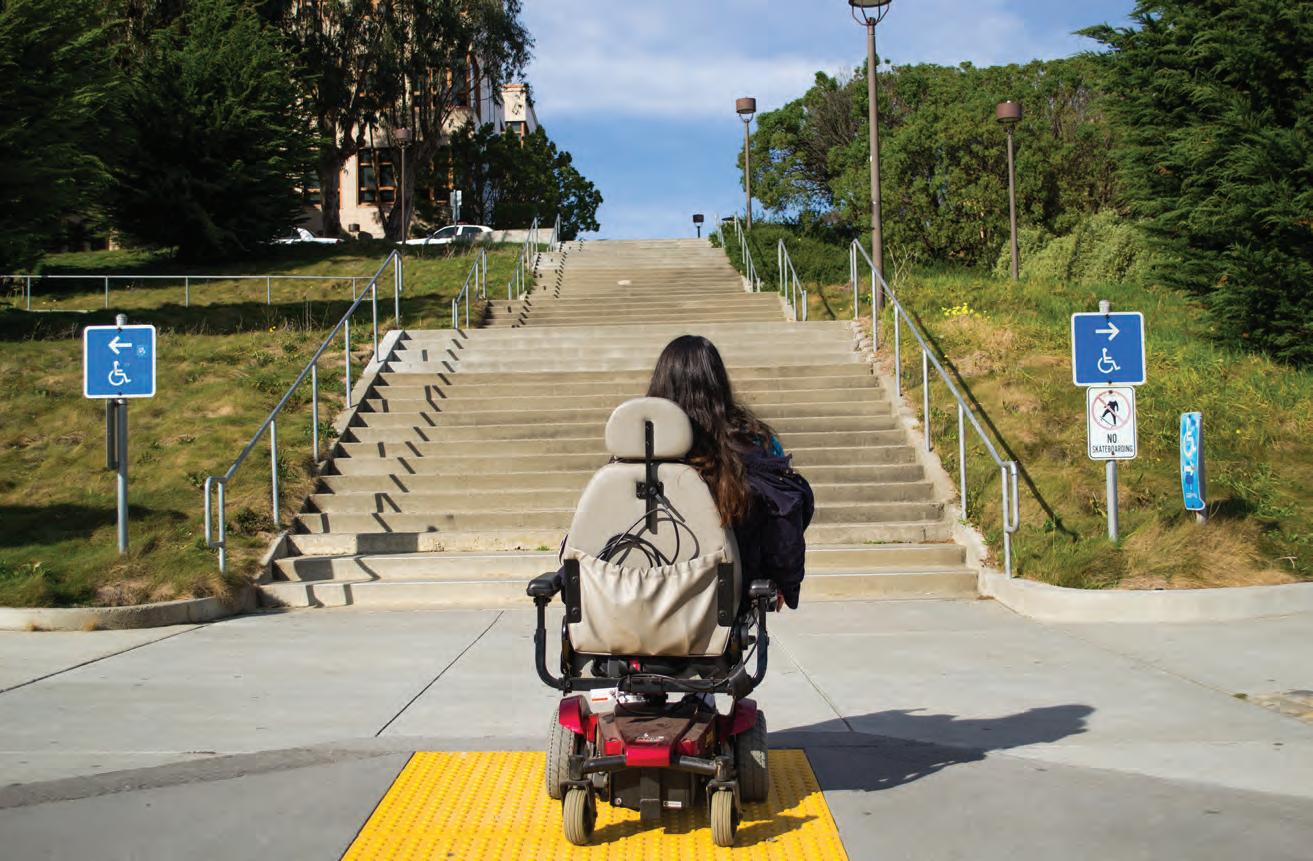 For Sarah Calvello, who takes classes on both the Ocean and Mission campuses, getting to school is often time-consuming and frustrating.
Photos by Chris Moreno
For Sarah Calvello, who takes classes on both the Ocean and Mission campuses, getting to school is often time-consuming and frustrating.
Photos by Chris Moreno
FIRST PERSON
17 ETC. MAGAZINE • Spring 2015 Wheeling And Dealing |
disability and the manual wheelchair didn’t help. But I soon realized how useful it would become. I began using it every time I left the house.
I later graduated to a Quickie all-terrain motorized wheelchair. Over the years, my dependence on it has grown.
Today, I sit for most of the day, which causes chronic back and leg pain. With my walker, I get fatigued after a block or two. I occasionally use a cane for shorter distances.
Back in high school, I was the only student using a wheelchair. It made feel alone. When a special ed teacher saw me playing with a staff member’s pit bull after school one day, he told me: “You need a dog.” He offered me a puppy from his lab’s litter as an early graduation present. She was the runt of the litter, which made her even more special. I named her Kamalanie, which means “child of the heavens” in Hawaiian.
Pets are very therapeutic. Kamalanie’s companionship made coping with my limitations easier.
In high school, I was over 200 pounds. I had low self-esteem and was on anti-depressants. Water aerobics classes helped. Every other week I went swimming at the Janet Pomeroy heated pool near the San Francisco Zoo. I got on the Atkins low carb diet. I ate a lot of meat and cheese… and avocados. But I had to limit my pasta intake.
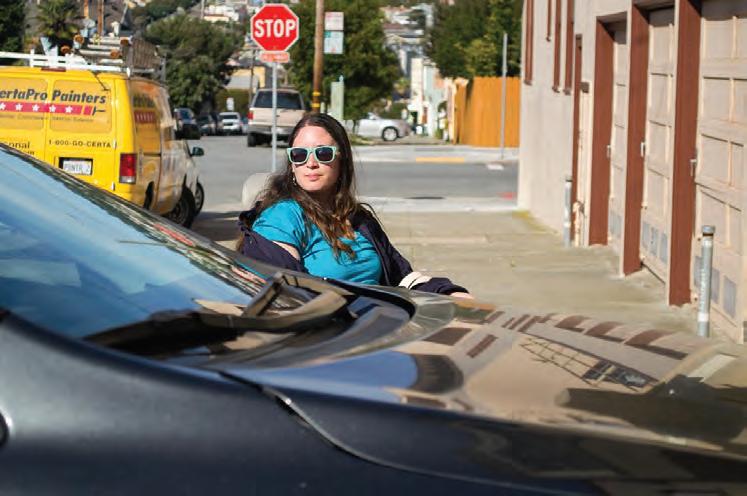
My parents separated after I graduated from high school. My mom moved out and I lived with my dad and brother in Parkmerced.
My ties to City College are deep. My dad, Michael Calvello, taught English and poetry here for 30 years and both my younger brother, Tony, and I attend school here now, as well. Tony, an English major, also has Friedreich’s ataxia. He walks to school with a cane from home.
Dad started teaching at City College when I was born in 1985 and helped start the school’s Puente Project, designed for Latino students interested in earning college degrees and returning to the community as mentors.
I decided to take one of his poetry writing classes in 2004. I was self-conscious at first. For two reasons. First, the teacher was my dad… and I didn’t want him reading and critiquing my poems. But he made it fun, and it brought us closer together.
It was our secret. No one else knew
he was my dad. In class, he called me Ms. Mahina, which is my middle name. It means “moon” in Hawaiian – and that’s poetic. He was a short, thin man who ate healthy and was addicted to ChapStick, like me. He was part Irish, English, Italian and Iroquois. He had high cheek bones, blue eyes and a ruddy complexion. With a little grin, his eyes would light up when he returned my papers and called on me in class. He gave Ms. Mahina an “A.”
Before class, we would have dessert and coffee at the Ocean campus cafeteria on Wednesday nights. Afterward, we’d separate so no one would see us together.
This is my favorite memory of my dad.
Maybe that’s why I associate writing with coffee and sweets.
My dad was a good teacher. I love poetry and I have him to thank for that. He taught me everything I know – about rhythm, rhyme, meter, prose, sonnets and Japanese haiku. And he shared his favorite poets –including Pablo Neruda. He introduced me to Rainer Maria Rilke’s “Letters to a Young Poet.” It was inspirational.
“Perhaps all the dragons in our lives are princesses who are only waiting to see us act, just once, with beauty and courage. Perhaps everything that frightens us is, in its deepest essence, something helpless that wants our love.”
Rilke’s words motivated me to write.
Dad worked at City College until he couldn’t work anymore. He died under
to pass it on the way to school and joke that we couldn’t even afford the toilet paper there. But I still fantasize about living there. In fact, I wrote a poem about it.
“Every time I pass the house on Bright Street
The one with the curvy gray turrets I think of you.
At the corner it is marked
“End and Bright”
You’ve finally come to the end of your fantastical Bright Street.”
I continue making my way along the back streets, where random houses look like mismatched shoes. I pass under deciduous trees that allow the sunlight to play with the shadows.
Being dependent on a wheelchair for transportation gives me more of an opportunity to observe my surroundings.
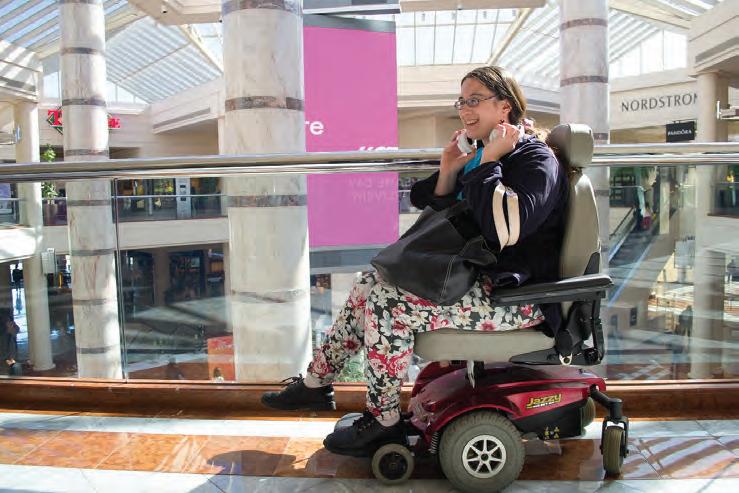
avoid taking them in the rain because they are usually so crowded. It’s just too much navigating around people’s feet.
Crowds and feet are not my friends.
Hospice care 11 years ago after a long battle with cancer. He had just turned 71. When he passed, I felt both happy and sad. The last time I saw him, he looked at me and said he was sorry… Sorry to leave us.
I have been taking classes off and on at City College since I was 19. Over the years I have seen people of different backgrounds and ethnicities brought together in a learning environment here. It certainly brought my dad and me closer together.
Although I still write poetry, I’m also interested in prose and creative non-fiction storytelling. (What do you think so far?)
Every day for me is like Groundhog Day.
I yank myself out of bed at 9 a.m. when I hear my babbling brook cell phone alarm. It goes off four more times to make sure I get up. I take my calcium tablets and Claritin allergy pills, wash them down with water, and head out the door. I get anxious if I can’t find my glasses and cell phone.
On my 2-mile motorized wheelchair journey to class, I pass an old guy in a Speedo sunning himself in a lawn chair in front of his Parkmerced townhouse. I don’t know who he is but I see a lot of him. His skin looks leathery. I have to bite my lip and turn away to keep from laughing. It’s embarrassing.
I pass the SF State coffee cart on the corner of 19th and Holloway, and head toward Ocean, where all the rich houses are. My favorite is the castle house – a Victorian at the end of Bright Street. Dad and I used
On Holloway, between Miramar and Granada, there’s a Spanish-style pink house with white lilies painted on it. This is where I usually have to maneuver around Jeeps and cars parked in the driveway.
Getting to school is like running an obstacle course. Bikers and skateboarders scare me.
When my back wheels hit raised cracks in the sidewalk, I get caught up and spun around, like Ginger Rogers in Fred Astaire’s arms. It’s a dance I do everyday. She did it in heels and backwards. I do it on wheels.
My wheelchair is capable of 4 miles per hour. I have to charge it overnight, and sometimes in class. The 12-volt battery can go up to 15 miles on one charge. The one I’m using now is red and black, and honestly just meant for home use so it goes slower than the monster Quickie one I prefer, which goes a lot faster. But it keeps breaking down on me – twice in the same place after leaving City College in front of Lucky Ocean Doughnuts. When the wheels deteriorated in a hot stinking mess below me and gave me a nasty surprise, I refused to ride it anymore.
The one I use now was given to me by a dead guy and has scratches on the back of the leather seat, courtesy of my mom’s cat.
During the winter, my hands get cold, even in gloves. It has to do with my neuropathy, which is a complication from muscular dystrophy. So, I have to make sure to stay warm. Sweaters and scarves are my constant companions.
On Tuesdays and Thursdays, my first class begins at 11 a.m., which gives me
enough time to bathe, get dressed and drive to school in my electric wheelchair. The mileand-a-half trip takes me about an hour.
While other students are thinking about racing to their next class, I have to make sure my wheelchair is charged. I bring my charger with me to school in the back of my wheelchair and charge it during class.
While taking notes, I drink home-brewed ice coffee from a ceramic thermos and snack on a Fiber One coconut and almond bar.
On Tuesdays, I’ve got six hours between classes. I make the return trip home for lunch with my roommate, Kyle, at the nearby Hall of Flame for a Flightless Falcon chicken sandwich with fries and a Diet Coke.
My evening class on the Mission Campus involves driving to West Portal and taking the 48-Quintara to Valencia. Then I drive a few blocks to the Mission Campus. It takes a couple of hours.
Crowded buses are a pain. The driver has to lower the lift for the chair and I need space near the door to park and exit from. I
When it pours, I have to wheel and deal. I usually get soaked. In my yellow rain poncho, I’m a sitting duck. I look like a wet banana. I run across a lot of dogs when I make my way around the City. I remember one in particular named Honey, a boxer mix who looks like Marmaduke. The second time I saw her, she jumped up, sat on my lap and licked my face.
I still miss my dog, Kamalanie – a chow, lab and German shepherd mix – who passed away last year. I had her since high school. She was my companion. We were together all the time. We both were disabled –Kamalanie had hip dysplasia. My mom had to bring her to the vet and have her put down. I think of her every time I pass the vet’s office on my way to school. I still keep her dog tags in my jewelry box at home. The first thing I do when I get home is park the wheelchair in an alcove near the front door. Exhausted, even doing laundry and household chores overwhelms me.
At the end of the day, my legs are unsteady and I walk around the house like I’m drunk. I don’t really like describing my clumsiness or talking about it, so writing this story has been challenging. It helps in some strange way to get it out, though. Maybe it will help someone else. My affliction slows me down. It makes time go by slower, and, most days, makes
Sarah Calvello, who drives to the Ocean campus in her wheelchair from Parkmerced, runs into all kinds of obstacles on her 2-mile journey here, including cars parked in driveways.
The author lives near Stonestown, which makes it more convenient for her shopping.
18 19 ETC. MAGAZINE • Spring 2015 ETC. MAGAZINE Spring 2015 | Wheeling And Dealing Wheeling And Dealing |
My ties to City College are deep. My dad taught poetry here for 35 years, and both my younger brother and I attend school here.
me feel like I’m older than I am. Yet it helps me appreciate every little movement. Fatigue is a big factor, so I have to pick and choose what I do carefully.
For example, if I have a full day of classes, the next day I sleep in and am somewhat useless to the world. I use the wheelchair for school, grocery shopping and outside chores. I should probably use the walker more than I do. I still get self-conscious when people stare, and I can’t stand it when they try to placate me.
At home, I get daily help from In-Home Supportive Services (IHSS), a federal program that provides household assistance for those on disability.
At school, I started using the DSPS program seven years ago, when I was 19. At first, I needed extra time on tests. DSPS set up a private testing room for me. Then I discovered their other services. I was able to borrow equipment, like an AlphaSmart keyboard that helped me type my notes. They loaned me a scooter when my old wheelchair broke down. A few semesters ago, I got a student notetaker for my classes. I have trouble writing quickly and legibly because of my nerve disorder. What DSPS offers me is the ability to function better in a fastpaced environment.
FA is like a not-so-funny good-news / bad-news joke. It forces you to appreciate the small things in life – especially the small triumphs you face everyday.
As with any ailment or disability, the bad news reality is you face your own mortality everyday.
Having a disability or impairment of any
kind forces you to be more introspective… to think more about cause and effect… action and consequence. It forces you to think about how any little thing you do can really affect every other thing you do.
The biggest obstacle I face is exercising and maintaining my weight. I’ve had a couple health scares. I get sick easily, due to a weak immune system. I often worry about my health, medications and sore muscles.
If I weren’t disabled, I doubt I would take the time to slow down and observe things. I wouldn’t be so focused. I enjoy the little things in life because I have to… I have to pick and choose the things I do, because everything I do takes more time and effort.
There is small comfort in the fact that other people have it harder than me. I don’t like to be patronized like that.
Looking down from the Ocean Avenue overpass near the main campus, I’m mesmerized by all the slow-moving traffic below.
I think life is like that – always on the move and noisy. You just need to find your own way through all that noise. Some of us are confined to the slow lane because of our physical limitations.
But the only thing that makes you disabled is your attitude. Like cars, we’re all just trying to find our destination.
Thousands of students and staff with disabilities depend on DSPS
Morethan 10 percent of American college students report having a disability, according to the National Center for Education Statistics.
Here at City College, the number of people with disabilities is in the thousands, including students, faculty and staff.
“The students we serve have a wide range of disabilities,” says Kathleen Duffy, who has been a Disabled Student Services counselor here for 17 years.
“We have students who have cognitive impairments, with psychological disabilities… mobility disabilities, who are deaf, blind, and deaf-blind,” Duffy points out. “We have young students, we have old students, and students with chronic medical conditions, such as HIV, diabetes, lupus, chemical sensitivity, chronic fatigue, and learning disabilities. We have students with ADHD. The list goes on and on.”
Duffy’s job is to level the playing field –to see where a disability impacts student’s ability in college, and try to provide reasonable accommodation to meet the require-

ments of the class.
DSPS supplies students with equipment to help them in the classroom. You can even rent wheelchairs for the day to make mobility easier.
“When the program first started I think it was mostly designed for students with physical disabilities and sensory impairments,” Duffy says. “Things have really evolved in terms of our society’s understanding of disability. I think more students with psychological disabilities are willing to ask for the accommodations that they need to do well.”
A lot of City College students returning from Afghanistan and Iraq have Post Traumatic Stress Disorder. And many students have PTSD who are not veterans – people who have had very difficult life experiences.
“I don’t think there’s a typical DSPS student,” says Duffy, who consults with instructors about how best to provide an accommodation without undermining what needs to be learned.
One of the things DSPS does is make assessment referrals for students with learning disabilities.
“In addition to counseling services,” Duffy says, “there are a lot of classes and labs we offer at City College. We have accessible computer labs that have a wide range of technologies to help students learn.
“City College is a place of second and third chances for people… I’ve seen so many people who have had so many barriers starting out, who flounder sometimes but then find what works for them. Everybody has something to give to the community and it’s really about students finding their path.”
There are a lot of success stories, she says.
“But success is different for different people. Sometimes success is getting a degree. Sometimes success is just being able to get out of the house and take a class.”
For more information, contact DSPS at: www.ccsf.edu/dsps or call (415) 452-5481 [(415) 452-5451 for the deaf].
– Sarah Mahina Calvello
20 ETC. MAGAZINE • Spring 2015 | Wheeling And Dealing
Calvello loves dogs. And they love her. This one leaped into her lap on the way to school.
Fall 2015 Journalism Classes
Classes start August 17, 2015. To register for courses go to www.ccsf.edu/schedule For more information call (415) 239–3446.
Jour 19: Contemporary News Media
3.0 units
76160 001 Lec. T R 09:40 – 10:55 a.m. HC 205
76881 551 Lec. W 06:30 – 9:20 p.m. Mission/Rm. 217
Graham
Graham
Introduction to modern mass communication, with an emphasis on development of news media, analysis of the credibility of the media and its impact on daily life. CSU/UC
Jour 21: News Writing and Reporting
3.0 units
76162 001 Lec. M W F 10:10 – 11:00 a.m. HC 203
Gonzales
Techniques of newspaper reporting, developing and writing a news story, training in information gathering and interviewing sources. PREREQ.: ENGL 93 or 94 or placement in ENGL 96
Jour 22: Feature Writing
3.0 units
35828 551 Lec. R 6:30 – 9:20 p.m. Mission Campus/Rm. 217
Rochmis
Fundamentals in feature writing for magazines and newspapers with special emphasis on profile and interpretive news features. Practical experience in interview and in-depth research techniques. Training in how to write a freelance story for publication.
Jour 23: Electronic Copy Editing
3.0 units
35829 551 Lec. W 6:30 – 9:20 p.m. Mission Campus/Rm. 218
PREREQ: ENGL 93 or 94 or PLACEMENT IN ENGL 96. CSU.
Rochmis
This course is for writers, working editors, and those considering a career in editing or copyediting. Students learn to edit newspapers, magazines and web site articles for accuracy, style and organization. The writer-editor relationship, and ways to keep it healthy, is emphasized throughout the course.
ADVISE: JOUR 21 CSU
Jour 24: Newspaper Laboratory
4.0 units
35829 551 Lec. M W F 12:10 – 1:00 p.m. BNGL 615
Gonzales
Advanced newspaper laboratory course focused on the publication of the college paper, The Guardsman. Plus four lab hours by arrangement. PREREQ: JOUR 21, ADVISE JOUR 22 CSU
Jour 26: Fundamentals of Public Relations
3.0 units
74606 551 Lec. T R 11:10-12:25 p.m. HC 205
Graham
Prepares students to create a public relations campaign which includes writing media releases, “pitch” letters, public service announcements, managing media outlets, coordinating mailings and designing leaflets and posters, as well as setting up news conferences. Special attention given to in-house public relations duties for corporate and non-profit entities. ADVISE: JOUR 24, and VMD 105
Jour 29: Magazine Editing & Production
75930 551 L/L T 6:30 – 8:20 p.m.
3.0 units
Mission Campus/Rm. 217
Lifland
Students will study the editorial, business, graphic, and production skills required for publishing Etc., the campus magazine. Course is appropriate for students interested in creative writing, editing, photography, graphic arts, business, and journalism. PREREQ: JOUR 23, ADVISE JOUR 22. CSU
Jour 31: Internship Experience
2.0 units
72312 551 Exp HOURS ARR BNGL 615
Gonzales
Supervised on-campus or off-campus employment in a branch of journalism or a closely allied field. ADVISE.: JOUR 24, Repeat Maximum credit: 4 units
Jour 35: Internet Journalism
2.0 units
76416 551 Lec T 6:30 – 8:20 p.m. BNGL 615
Rochmis
Internet journalism focuses on three topic areas; examination of the role of the online journalist, web publishing, and using the internet for investigative purposes. ADVISE: JOUR 21 Requires one additional hour per week.
Jour 36: Advanced Reporting
75932 551 Lec. M 6:30 - 9:20 p.m.
3.0 units
Mission Campus/Rm. 217
Gonzales

The course includes advanced concepts of news gathering, interviewing and writing with an emphasis on investigative reporting. Extensive research, interviewing, meeting coverage and writing involved. Students will improve and expand their news-gathering and writing skills. ADVISE: JOUR 21
LATE START CLASSES: l Jour 37: Intro to Photojournalism
l Jour 38: Intermediate Photojournalism
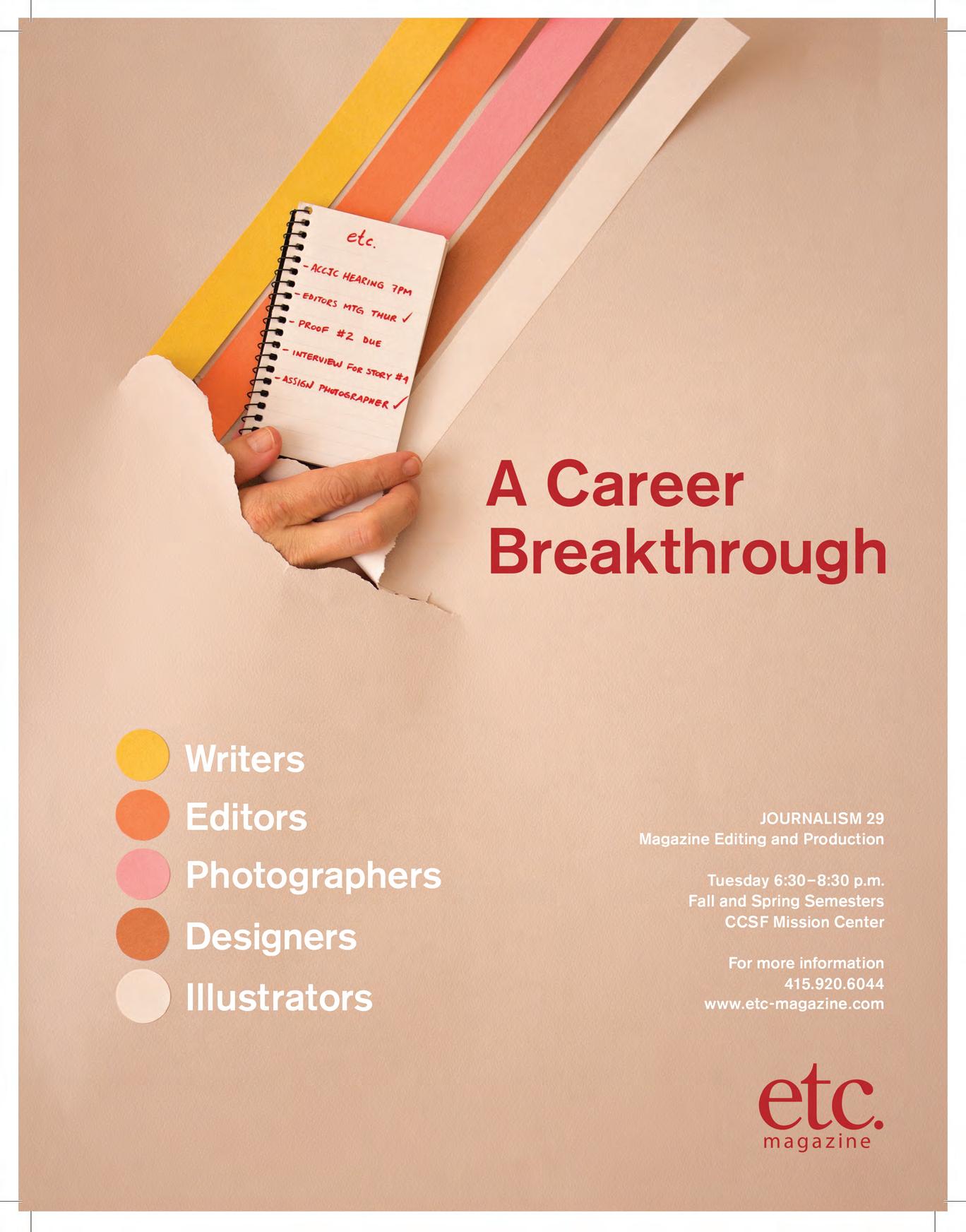















 Ed, 68, and Ray, 67, now retired as cable car gripmen, shared a life-long dream of their father’s. They got to ride the rails throughout the City every day. It was never boring, they said.
Thirty years ago, straight out of college, Ray was just beginning his career as a gripman.
Ray Rezos, now retired, recently gripped the familiar controls of one of MUNI’s cable cars.
Ed, 68, and Ray, 67, now retired as cable car gripmen, shared a life-long dream of their father’s. They got to ride the rails throughout the City every day. It was never boring, they said.
Thirty years ago, straight out of college, Ray was just beginning his career as a gripman.
Ray Rezos, now retired, recently gripped the familiar controls of one of MUNI’s cable cars.













 Photo by Nick Neumann
Photo by Walker Dawson
Photo by Walker Dawson
Dusk on Ilha Grande, an island off the coast of Rio de Janiero. Night view of South America’s largest favela, Rocinha, Rio de Janiero.
Photo by Nick Neumann
The world’s largest salt flats (4,086 square miles) – Salar de Uyuni – are located in southwest Bolivia.
Photo by Chris Moreno
Photo by Nick Neumann
Photo by Walker Dawson
Above: The view of Rio de Janiero from the helicopter pad atop Corcovado, near the imposing statue of Christ the Redeemer.
Left: A pick-up game of soccer in one of Rio’s many favelas.
Right: A motorcyclist on an unpaved highway rides toward Ouro Verde, Goiás.
Photo by Nick Neumann
Photo by Walker Dawson
Photo by Walker Dawson
Dusk on Ilha Grande, an island off the coast of Rio de Janiero. Night view of South America’s largest favela, Rocinha, Rio de Janiero.
Photo by Nick Neumann
The world’s largest salt flats (4,086 square miles) – Salar de Uyuni – are located in southwest Bolivia.
Photo by Chris Moreno
Photo by Nick Neumann
Photo by Walker Dawson
Above: The view of Rio de Janiero from the helicopter pad atop Corcovado, near the imposing statue of Christ the Redeemer.
Left: A pick-up game of soccer in one of Rio’s many favelas.
Right: A motorcyclist on an unpaved highway rides toward Ouro Verde, Goiás.





 For Sarah Calvello, who takes classes on both the Ocean and Mission campuses, getting to school is often time-consuming and frustrating.
Photos by Chris Moreno
For Sarah Calvello, who takes classes on both the Ocean and Mission campuses, getting to school is often time-consuming and frustrating.
Photos by Chris Moreno




